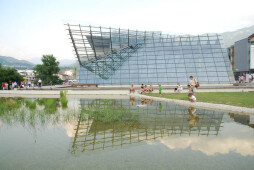MUSE is one of the major attractions in the Quartiere delle Albere, the new 116,300 m² eco-district, built on the former Michelin site in Trento, Italy.
This large interactive science museum is part of an ambitious environmental redevelopment project that reconnects the city with its natural surroundings, the Adige river and the Dolomites.
With the aim of achieving LEED Gold (Leadership in Energy and Environmental Design) certification, the building was designed with the greatest respect for environmental sustainability standards, consumes very little energy and prioritises renewable resources.
Mermet's Satiné 5501 fabric was a natural choice, both for its performance and for the comfort it provides for the building’s users.
Satiné 5501 interior fabric blind
This dense fabric:
• provides total glare control by filtering out up to 98% of light rays (Tv = 2%),
• resists fading due to UV radiation, which it filters at up to 98%,
• provides excellent heat protection – up to 83% of solar energy is blocked in interior use.
Transparent, with an openness factor of 1%, it is suitable for both interior and exterior use.
Fine (0.55 mm ±5%) and lightweight (450 g/m² ±5%), Satiné 5501 fits into compact casings. Its excellent dimensional stability makes it a perfect fit for ZIP-type side channel mechanisms.
It is also highly durable (10,000 cycles, class 3 NF EN 13561) and perfectly smooth.
Like all Mermet's sun protection fabrics, Satiné 5501 meets the health and safety standards for buildings open to the public (fire rating M1 NFP 92 503, Greenguard® Gold).
In terms of both solar reflection and glare control, the performance of the Satiné 5501 fabric from Mermet plays an essential role in keeping the Trento museum’s users comfortable.
Above all, by contributing to the building's LEED Gold certification, Mermet proves that sun protection has become an essential aspect of any effective environmental project.





































